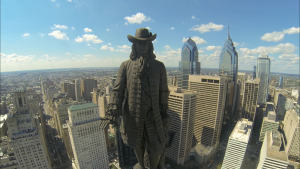Are we experiencing Philadelphia’s biggest development boom in almost 50 years?
 |
| Fantastic shot courtesy of BillyPenn.com |
In my professional opinion … maybe. Since I’ve only been alive since ’79, it’s kind of hard for me to say.
Here is what I will say. No matter how experienced you are as an agent, no matter how long you have been selling Philadelphia real estate, it’s very difficult for anyone to give a straight answer to that question or predict the future of the local market.
But … when you have someone who is as experienced and credible as Alan Greenberger (Philadelphia’s current Deputy Mayor for Economic Development & Director of Commerce) say that he has not seen a boom like this since ’74 (the year he moved from NYC to PHL), you know that something unique is currently happening in the City of Brotherly Love.
So, how is 2015 any different than the last real estate wave that ended in 2008? The answer, global awareness of Philadelphia’s affordability and accessibility.
As I have stated in the past, Philadelphia is not one of the most affordable cities in the US, but we are one of the largest and most affordable cities in the “Northeastern” US. On top of that, we are a Top US global gateway metro, with our neighbor NYC being the largest. “The Northeast” is the most economically developed, densely populated, and culturally diverse region in the entire US. There is more urbanized land than any other part of the country, and we also enjoy large amounts of forest-use/green space (about 60% in total, which is about twice the US average). From just Pennsylvania to Maine, the area is home to over 55M people.
When you are located right in between the Financial Capital of the US (NYC, which in 2014 was also named the “World’s Leading Financial Centre”) and the Political Capital of the US (DC, or course), you are guaranteed to receive some attention. Now that Philadelphia has really begun to come into its own, with Center City, University City, and the Navy Yard all leading the charge, the world now has its eyes on us.
And when they get here, they will realize just how affordable and accessible Philadelphia really is!
Based on the city’s size, as well as the size of the surrounding suburban metro area, you can get almost anywhere using a form of public transportation (i.e. train, subway, or bus). Now that Uber has entered the Philadelphia transportation market, it’s even easier. This is due to the metro area’s compactness, which is a product of density and smart planning over the last 300+ years.
Okay, back to Greenberger.
This article states that he sees the current real estate boom in Philadelphia continuing for the next 5-10 years, although maybe not at the same pace throughout that entire time frame. There are still many highly accessible areas in both North/South Philadelphia that have yet to be touched by redevelopment/reimagination from the millennial generation, as these are the folks that are making cities like Philadelphia great again.
Just like the Market-Frankford Line has redefined neighborhoods like Northern Liberties, Fishtown, and Kensington, the Broad Street Line has the same potential.
It will be interesting to see what happens over the next 5-10 years, and if Greenberger’s prediction is right. Either way, it’s a very exciting time to be living in Philadelphia.

